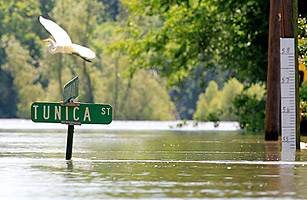
The talk of New Orleans has centered on whether the most severe Mississippi River flood in more than a quarter-century will cause catastrophic damage to a city still recovering from Hurricane Katrina. And for good reason: the flood has carved a destructive path from from Cairo, Illinois, to Vicksburg, Mississippi, and prompted Louisiana’s Republican governor, Bobby Jindal, to ask the federal government for emergency assistance. But there just might be a silver lining: the flood could actually help Louisiana’s fragile wetlands.
To be sure, the Mississippi River’s floodwaters are destructive. Many people along the spillways opened to alleviate the surge are likely to lose their homes. The water may also destroy oyster beds, especially in Lake Borgne, between the Mississippi River and the Gulf of Mexico. Longer-term effects won’t be clear for several months. But, says Alex Kolker, a geologist at the Louisiana Universities Marine Consortium, it may be an opportunity to let nature help resolve a man-made problem. “It’s going to be a fascinating time,” says Kolker.
Only a year ago, the worst oil spill in American history slathered millions of gallons of oil across Louisiana’s coast. The muck covered the tall, bamboo-like cane and short grass that stitches together the vegetation that makes up the wetlands south of New Orleans, preventing them from receiving oxygen. Many experts feared it would take years for the wetlands to recover, and that Louisiana’s core seafood industry — especially the oysters, which unlike shrimp and fish cannot run away from hint of oil — was imperiled. Such sediment is crucial: the loss of vegetation quickens erosion of soil and islands.
Now, however, sediment-rich floodwaters are headed for the contaminated wetlands. The U.S. Army Corps of Engineers, manager of much of the nation’s waterways, has, over the last century, set up a framework of Mississippi River containment that has ultimately deprived the Delta’s wetlands of much-needed silt. That reduced sediment has, experts say, accelerated the shrinking of the Delta. Now, however, the agency has opened two channels to divert part of the Mississippi away from New Orleans and toward the wetlands. One channel is the Bonnet Carre spillway, which is funneling water into Lake Pontchartrain, and, from there, to the Gulf of Mexico. The other is the Morganza spillway, which sends water along the Atchafalaya River Basin and into the Gulf. The water and sediment forced through this channel, experts say, will likely help replenish the wetlands to the west of the Mississippi with fresh sediment, especially near fishing and shrimping villages like Dulac. The last major flood, in 1973, delivered enough sediment to create what are now large mud banks covered with lush grass and trees. Those banks have provided some of the crucial defenses of New Orleans during major storms.
The flood will, to some degree, flush out the oil remaining from last year’s spill. Some of the oil will mix with the new sediment and, depending on its weight, that amalgam will be pushed by the Mississippi’s current into the Gulf. “That doesn’t mean it’s not a problem,” warns Richard Steiner, a marine conservationist who has studied the effects of the Exxon Valdez oil spill, and BP’s spill in the Gulf. His chief concern: the thick, dark, weathered oil-infused mixture will remain toxic and continue to imperil the Gulf, and certainly much of Louisiana’s wetlands, though perhaps with lower concentrations of contamination. There’s also the risk that some of the remaining wildlife will become slathered with the re-emergent oil, and die. Still, says Steiner, the best route to saving Louisiana’s wetlands may ultimately be to “just leave it to natural degradation.” As fearsome as they may be, the waters of the flood are all part of nature’s work.
See how New Orleans is reacting to the Mississippi River floods.
See the top 10 historic U.S. floods.